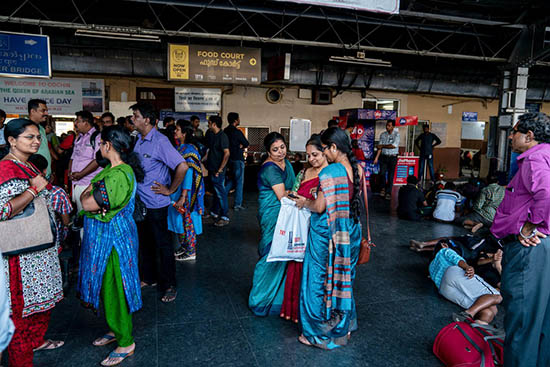谷歌在印度:希望、梦想和机遇
|
谷歌已经在印度运营多年,早在2004年就在班加罗尔开设了第一家位于美国本土之外的研发中心。但现如今,这家科技巨头决意在该国大举扩张,其时机可谓恰到好处。对工商界颇为友好的印度总理纳伦德拉·莫迪,已经将数字革命作为施政核心。一些印度企业集团一直在响应他的号召。莫迪在2014年竞选时承诺让所有印度人上网。然后,在2016年,他废除了印度当时流通的大部分纸币,从而有效地促使数百万人使用数字支付系统。政府还将医疗保险等公共服务放到了网上,并于2016年在全国范围内推行一项要求企业提交数字记录的销售税。新改版的国民身份证现在能够收集每个公民的生物特征数据。 |
GOOGLE HAS BEEN OPERATING in India for years, having opened its first non-U.S. R&D center in Bangalore in 2004. But its push to expand in the country is now exquisitely well timed. The pro-business Prime Minister Narendra Modi has made a digital revolution the centerpiece of his government. And some Indian conglomerates have been answering his call. Modi campaigned for office in 2014 on a promise of getting all Indians online. Then in 2016 he invalidated most of India’s paper currency in circulation at the time, effectively pushing millions onto digital payment systems. The government also put public services like health insurance online, and it introduced a national sales tax in 2016 that required businesses to file digital records. A national ID card now collects biometric data on every citizen. |

|
印度的数字政策有时显得过于专横,让许多穷人苦不堪言。但官员们坚称,唯有采取孤注一掷的措施,才有望推动现金占据绝对主导地位,大多数人不纳税的印度经济得以改善。每个月约有100万印度人进入就业市场,但大多数人仍然生活在农村,机会少得可怜。“要想实现每年9%或10%的增长,我们需要的不仅仅是实体基础设施,还需要数字基础设施。”改造印度国家研究院(NITI Aayog)的首席执行官阿米塔布·康德表示。这家拥有官方背景的研究院是印度数字化战略的领导机构。康德在他的新德里办公室接受采访时宣称:“倘若我们到处建造实体银行和实体学校,聘请银行经理的话,那将需要数百年的时间。”外面的大厅摆放着一尊圣雄甘地雕像——这位印度民族英雄裹着纱笼,正在冥想,脚边放着玫瑰花瓣。它微妙地提醒人们,印度的数字政策是出于国家利益考量。“中国花了30年让大部分人口摆脱贫困,美国则花了将近100年时间。”康德说。“印度在未来15年实现脱贫目标的唯一途径就是数字化跨越。” 如果不是印度最大的企业集团信实工业多年前做出的一项决定,这种数字化跨越可能会在一开始就遭遇失败。2011年,以石油和基础设施作为核心业务的信实工业决定建设一个庞大的宽带网络,尽管该公司并没有相关经验,更不用说这个领域还有很多竞争对手。信实收购了一家拥有移动频谱经营牌照的电信公司,随即与其他公司展开正面较量。彼时,只有2800万印度人拥有智能手机。信实的目标是用宽带覆盖印度,而当时只有大城市才能享受这种服务。于是,在建造了几十年管道和炼油厂之后,信实在印度各地建起了22万座移动通信塔,通常一天就能建成700多座。该项目总共耗资300多亿美元。 2016年9月,信实隆重推出Reliance Jio电信网络,并且为新用户提供前六个月移动数据免费礼包。印度人不愿错过这个机会,争相恐后地报名登记。在短短六个月内,Reliance Jio就签下了 1 亿用户。在去年9月成立两周年之际,该公司的签约用户已达2.5亿人。其廉价的“流量包”引发一场价格战,拉低了印度的数据价格——现在,每 GB数据的价格已经从2016年的4.50美元左右降至区区15美分——由此显著蚕食了竞争对手的利润。事实证明,这种定价策略堪称神来之笔,它确立了信实作为一家手机和互联网服务供应商的傲然地位。Reliance Jio现在销售价格为20美元的手机,并且正在推出面向汽车、电视显示器和家用电器的联网设备。 |
India’s digital policies have seemed dictatorial at times, and for many poorer Indians, they have been painful. But officials insist desperate measures are essential to improve an overwhelmingly cash economy, where most people pay no taxes. About a million Indians enter the job market every month, yet most people still live in rural villages, with few opportunities. “More than physical infrastructure, we need digital infrastructure if we are to grow at 9% or 10% a year,” says Amitabh Kant, CEO of the government’s National Institution for Transforming India, or NITI Aayog, which spearheads India’s digital strategy. “If we were to go around building physical banks and physical schools, and hiring bank managers, it would take us hundreds of years,” Kant says, sitting in his New Delhi office. Outside, the lobby features a statue of national hero Mahatma Gandhi meditating in a sarong, with rose petals at his feet—a subtle reminder that India’s digital policies are for the good of the nation. “China took 30 years to lift the vast segment of its population above the poverty line. America took close to 100 years,” says Kant. “The only way India can do this in the next 15 years is to digitally leapfrog.” That leapfrogging might have sputtered on takeoff had it not been for a decision taken by one giant Indian company, the country’s biggest conglomerate, Reliance Industries. In 2011, Reliance, whose core business was oil and infrastructure, decided to build a vast broadband network, a business in which it had no experience but plenty of rivals. It had acquired a telecom company that owned mobile spectrum licenses, and it muscled in on its competitors. Barely 28 million Indians then owned smartphones. Reliance aimed to blanket India with broadband coverage, which was available only in big cities. After decades building pipelines and refineries, Reliance erected 220,000 mobile towers across India, often building more than 700 in a single day. In all, the project cost more than $30 billion. In September 2016 it launched the Reliance Jio telecom network, offering people free mobile data for the first six months. Indians stampeded to grab the offer. Reliance Jio signed 100 million subscribers within six months and 250 million by its second anniversary last September. Its cheap plans set off a price war and drove down India’s data prices, from about $4.50 a gigabyte in 2016 to a rockbottom 15¢ now, cutting deeply into competitors’ profits. For Reliance the pricing proved a masterstroke, establishing itself as a key phone and Internet service provider. Reliance Jio now sells $20 phones, and it is rolling out connected devices for cars, TV monitors, and home appliances. |

|
拜Reliance Jio史诗般的影响力所赐,印度迅速地从一个数字封闭落后之所转变为世界上互联网发展速度最快的国家。在《财富》杂志去年9月发布的年度“改变世界”企业榜单中,Reliance Jio高居榜首。“如果你仔细想想,你会看到经济差距、语言不平等和距离不平等,而这些正是我们从根本上突破的障碍。”当我在位于孟买郊区、绿树成荫的Reliance Jio园区见到该公司的总裁马修·乌曼时,这位来自于印度南部的喀拉拉邦、曾经在美国无线运营商Sprint担任首席技术官的高管这样说道。他说,他深信廉价的数据已经永恒地提振了印度人的前景。他以宏大的词汇描述其成果。“他们不仅仅是网络连接的用户,而且已经成为数字经济体的公民。”他说。“这是从根本上颠覆印度社会和经济结构的工具。” |
For India, Reliance Jio’s impact has been seismic. The country went from being a digital backwater to being home to the world’s biggest boom in Internet usage. Last September, Fortune placed Reliance Jio in the first spot on its annual Change the World ranking of companies. “If you think about it, we saw economic disparity, language inequality, and distance inequality. And that is what we fundamentally broke,” says Reliance Jio president Mathew Oommen when we met at Reliance’s leafy campus on the edge of Mumbai. Oommen, who is from the southern Indian state of Kerala, was previously chief technology officer for the U.S. cellular company Sprint. He says he is convinced that cheap data has forever boosted Indians’ prospects, and he speaks of the results in grandiose terms. “They did not just become subscribers of connectivity. They have all become citizens of the digital economy,” he says. “This was just the vehicle to fundamentally disrupt the social and economic fabric of India.” |













